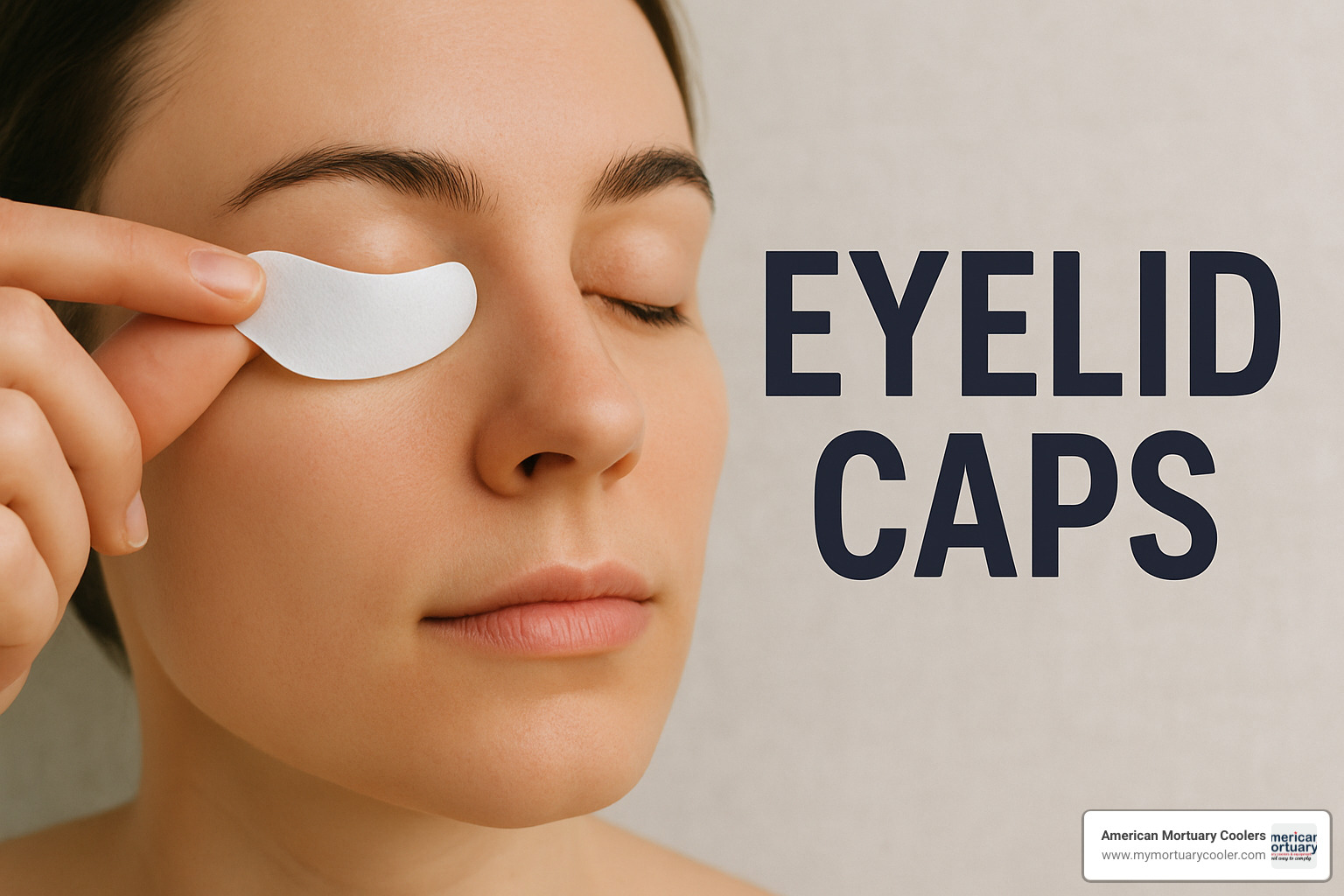Understanding Essential Mortuary Tools: Eyelid Caps
Eyelid caps are specialized mortuary devices designed to keep a deceased person's eyes closed during viewing and funeral services. They serve a crucial role in mortuary preparation.
| Quick Facts About Eyelid Caps |
|---|
| Purpose: Keep deceased's eyes closed naturally |
| Material: Usually plastic or silicone with perforations |
| Cost: $7-30 per pack of 100 |
| Users: Funeral directors, embalmers, morticians |
| Placement: Under the eyelids like contact lenses |
Eyelid caps (also called eye caps or ocular caps) are small, concave discs with needle-pointed perforations that help secure the eyelids in a natural closed position. These simple yet essential tools are placed under the eyelids during the embalming process to restore a peaceful, lifelike appearance and prevent the eyelids from opening during viewing services.
Unlike cosmetic eyelid tapes used by living individuals, mortuary eyelid caps are specifically designed for postmortem care. They work by creating gentle friction through their perforated surface, which grips the underside of the eyelid tissue to maintain closure. This is particularly important when preparing a body for an open-casket viewing, as proper eye closure contributes significantly to the dignified presentation that helps comfort grieving families.
Professional embalmers consider eyelid caps a standard supply in funeral preparation. The caps are especially valuable in cases where eye donations have occurred or when natural eye closure is difficult to achieve through other methods. Their design has remained largely unchanged for decades, proving their effectiveness in mortuary practice.
I'm Mortuary Cooler, a national-level mortuary cooler supplier with extensive experience providing essential mortuary equipment including eyelid caps to funeral homes across America. My professional background includes advising funeral directors on the most suitable preparation room supplies to ensure dignified presentation of the deceased.
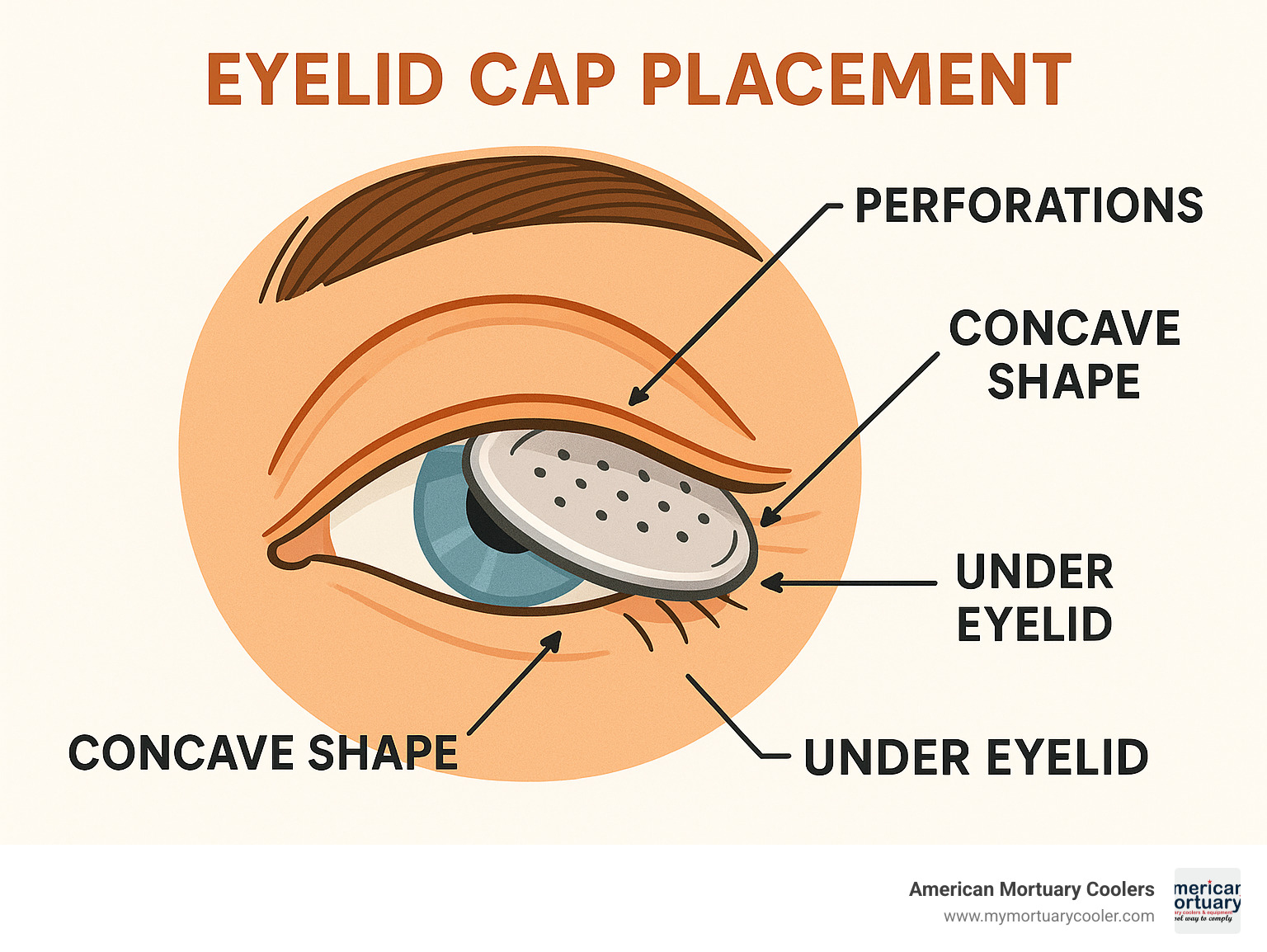
Eyelid caps word list:
What Are Eyelid Caps?
Eyelid caps are clever little tools that morticians and funeral directors use to help the deceased look peaceful and at rest. These small, concave discs fit beneath the eyelids, working like gentle supports that keep the eyes naturally closed during viewings and funeral services.
The story of eyelid caps is woven into the history of modern funeral care. As embalming practices evolved in America, morticians needed better solutions than simple stitches or glues to maintain dignified eye closure. While we don't know exactly who invented them or when, these practical devices have become trusted companions in preparation rooms across the country.

I remember talking with a veteran embalmer who described them perfectly: "These perforations are quite soft and just enough to keep the lid from slowly creeping up." It's this simple yet brilliant design that has stood the test of time, remaining largely unchanged for decades in mortuary practice.
Key Functions of Eyelid Caps
When we prepare someone for their final viewing, eyelid caps help us in several important ways.
First and foremost, they ensure the eyes remain gently closed. This might seem straightforward, but without some assistance, eyelids can partially open during the embalming process or even during the viewing period – something that can be distressing for family members.
They also help restore the natural shape of the eye area. Sometimes, especially in cases of illness or eye donation, the eye area may appear sunken. Eyelid caps help maintain that natural contour that families recognize in their loved ones.
For those who have generously donated their eyes, these caps are particularly valuable. They help create the appearance of fully closed eyes, preserving dignity and a peaceful expression.
They also create a protective barrier that prevents any potential fluid leakage from the eye area during viewings – an important practical consideration in our work.
As one of my colleagues once explained, "Applying eye caps is a bit like fitting contact lenses." This comparison really captures both the delicate touch required and the skill that goes into proper placement.
Differences Between Eyelid Caps and Natural Protective Structures
Nature has its own version of eye protection that's fascinating to compare with our mortuary eyelid caps. If you've ever looked closely at a snake, you might have noticed they don't blink like we do. That's because they have something called a "brille" or spectacle.
This brille is essentially a transparent scale that permanently covers the snake's eye. Unlike our eyelids that open and close, this natural eye cap is fixed in place, protecting the eye while still allowing the snake to see. When snakes shed their skin, this protective layer comes off too.
The world of natural eye protection doesn't stop with snakes. Some bony fish have what's called an "adipose eyelid" – another type of transparent protective covering that serves a similar purpose.
The main differences between these natural structures and our mortuary eyelid caps are pretty interesting:
While the brille evolved as a living protective shield, our eyelid caps serve a more aesthetic and practical purpose in funeral care. The brille is made of living tissue that's part of the animal's regular skin-shedding process, whereas our caps are manufactured specifically for mortuary use. And while nature's eye caps are permanent features until shed, ours are carefully placed after death to help create that peaceful final appearance.
These comparisons remind us that whether through evolution or human innovation, the protection and presentation of the eyes has always been important – in life and in our final farewells.
How Eyelid Caps Work: Design, Materials, and Types
The magic of eyelid caps is in their thoughtful design. These small, concave discs perfectly mimic the natural curve of the human eye, providing just the right support to keep eyelids in a peaceful, closed position. What makes them truly effective are the series of clever angled perforations or mesh-like openings across their surface.
As one experienced mortician once shared with me, "These perforations are quite soft and just enough to keep the lid from slowly creeping up." There's real intention behind those tiny angled holes—when the eyelid rests on the cap, the delicate tissue catches slightly on these perforations. This creates just enough gentle friction to keep everything in place without causing any damage to the tissue.
Standard mortuary eyelid caps are quite different from their medical and cosmetic cousins:
| Type | Primary Use | Design Features | Typical Materials |
|---|---|---|---|
| Mortuary Eye Caps | Postmortem preparation | Concave with angled perforations | Plastic, silicone |
| Medical Eye Shields | Radiation therapy, surgery | Solid with tungsten/aluminum | Metal with plastic caps |
| Cosmetic Eyelid Tape | Beauty improvement | Adhesive strips | Hypoallergenic adhesives |
Materials Used in Eyelid Caps
The materials chosen for eyelid caps strike a careful balance between durability and gentleness. Most are crafted from medical-grade materials that won't deteriorate or cause tissue reactions. The most common include:
Polyethylene creates lightweight, flexible caps that naturally conform to the eye's shape. Polystyrene offers a bit more structure while maintaining the needed curve. For premium options, soft silicone provides superior tissue compatibility.
The material choice matters deeply because it needs to be firm enough to hold its shape while being gentle on the delicate eyelid tissue. At American Mortuary Coolers, we take pride in providing eyelid caps made only from high-quality materials that meet or exceed professional standards.
Specialized Variants: Radiation Shields & Surgical Eye Caps
Beyond the funeral home, specialized eye caps serve important medical purposes too:
Radiation Eye Shields protect patients' eyes during cancer treatments. Unlike our mortuary eyelid caps, these medical shields feature tungsten construction (usually 2-3mm thick) that blocks harmful radiation, with aluminum caps (0.5-1mm) to control electron backscatter. They're even designed differently depending on the energy level of the treatment.
Medical literature often notes specific guidelines like: "Use a 3mm tungsten eye shield for 9 MeV and a 2mm tungsten eye shield for 6 MeV. These shields are not recommended for use above 9 MeV."
Surgical Eye Caps have their own special role during procedures like blepharoplasty (eyelid surgery). They shield the cornea during delicate manipulations, help maintain the eye's natural shape during reconstructive work, and sometimes provide surgeons with a guide for precise incision placement.
While these medical versions serve very different purposes than our mortuary eyelid caps, they share the same fundamental goal – protecting and supporting the eye area with care and precision during specialized procedures.
Application & Removal Techniques, Safety, and Comfort
Applying eyelid caps is truly an art form that blends technical skill with compassionate care. Many funeral professionals compare it to inserting contact lenses – it requires a gentle touch and careful attention to detail. Having prepared countless loved ones for viewing, I can tell you that this small step makes a world of difference for families.
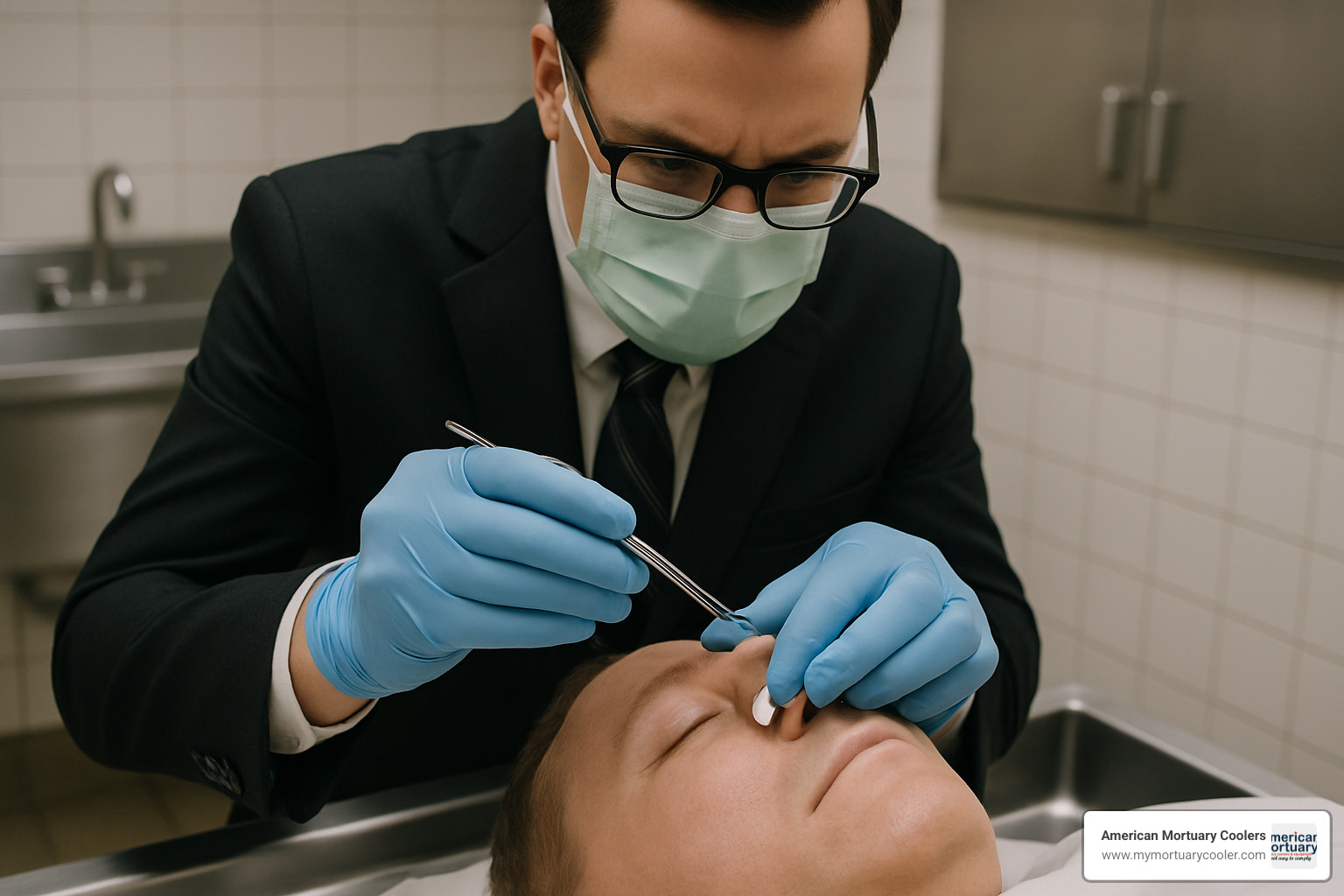
Step-by-Step Guide to Applying Mortuary Eyelid Caps
The application process begins with gentle cleansing of the eye area. We carefully remove any moisture or discharge and ensure the surrounding area is clean and dry. Selecting the right size cap is crucial – most people fall within standard sizes, but occasionally we need something custom for a perfect fit.
The actual placement is where experience really matters. We delicately lift the upper eyelid and position the eyelid cap directly on the eye (or in the orbital cavity for donation cases). The perforated side faces the underside of the eyelid – those tiny holes are what create the gentle friction that keeps everything in place.
Once positioned, we carefully lower the eyelid over the cap. The magic happens when those tiny perforations naturally grip the underside tissue. I always take a moment to step back and check both eyes for symmetry and a natural appearance. Sometimes small adjustments make all the difference.
For eye donation cases, eyelid caps are especially valuable. As one supply company notes, they "help restore the normal appearance of the eyelids" when the eyes have been donated. Many of us combine them with other products like cavity filler to create the most natural result possible and prevent any leakage issues.
"I've found that taking an extra minute to ensure perfect placement saves time later and creates the most peaceful appearance," shared one of our funeral directors in Tennessee. "Families notice these details, even if they don't realize exactly what they're seeing."
Are Eyelid Caps Safe and Comfortable?
When it comes to the deceased, comfort isn't a concern, but dignity and appearance certainly are. Properly applied eyelid caps should create no visible pressure marks or unnatural distortion. They should maintain a perfectly natural eyelid position and stay secure throughout the viewing period.
For living patients using medical eye shields or cosmetic products, comfort and safety become paramount concerns. Medical-grade materials and proper sizing prevent irritation and potential corneal damage. This is why we're so particular about the quality of materials in the products we recommend.
Infection control is something we take very seriously in funeral service. Eyelid caps are strictly single-use items – they should never be reused between cases under any circumstances. At American Mortuary Coolers, we emphasize proper sanitation in all our training materials for funeral professionals across the country, from busy urban funeral homes in New York to small family operations in rural communities.
I remember one funeral director telling me, "These little caps are one of those things families never see or know about, but they make all the difference in creating that peaceful final image they'll carry with them." It's these thoughtful touches that help create meaningful goodbyes.
Who Uses Eyelid Caps & When To Choose Alternatives
Eyelid caps aren't just tools for the funeral industry – they're part of a broader family of eye-related devices used by several different professionals and individuals. While morticians might be the most common users, these specialized tools serve various purposes across different fields.
Funeral directors and embalmers rely on traditional perforated eyelid caps during the preparation process, ensuring the deceased looks peaceful and natural during viewing services. These professionals have mastered the delicate art of applying these caps to achieve the most lifelike appearance possible.
Medical professionals like ophthalmologists and radiation oncologists also use specialized eye shields – though their versions are designed for living patients undergoing treatments. These medical shields protect vulnerable eye tissue during procedures rather than maintaining closure.
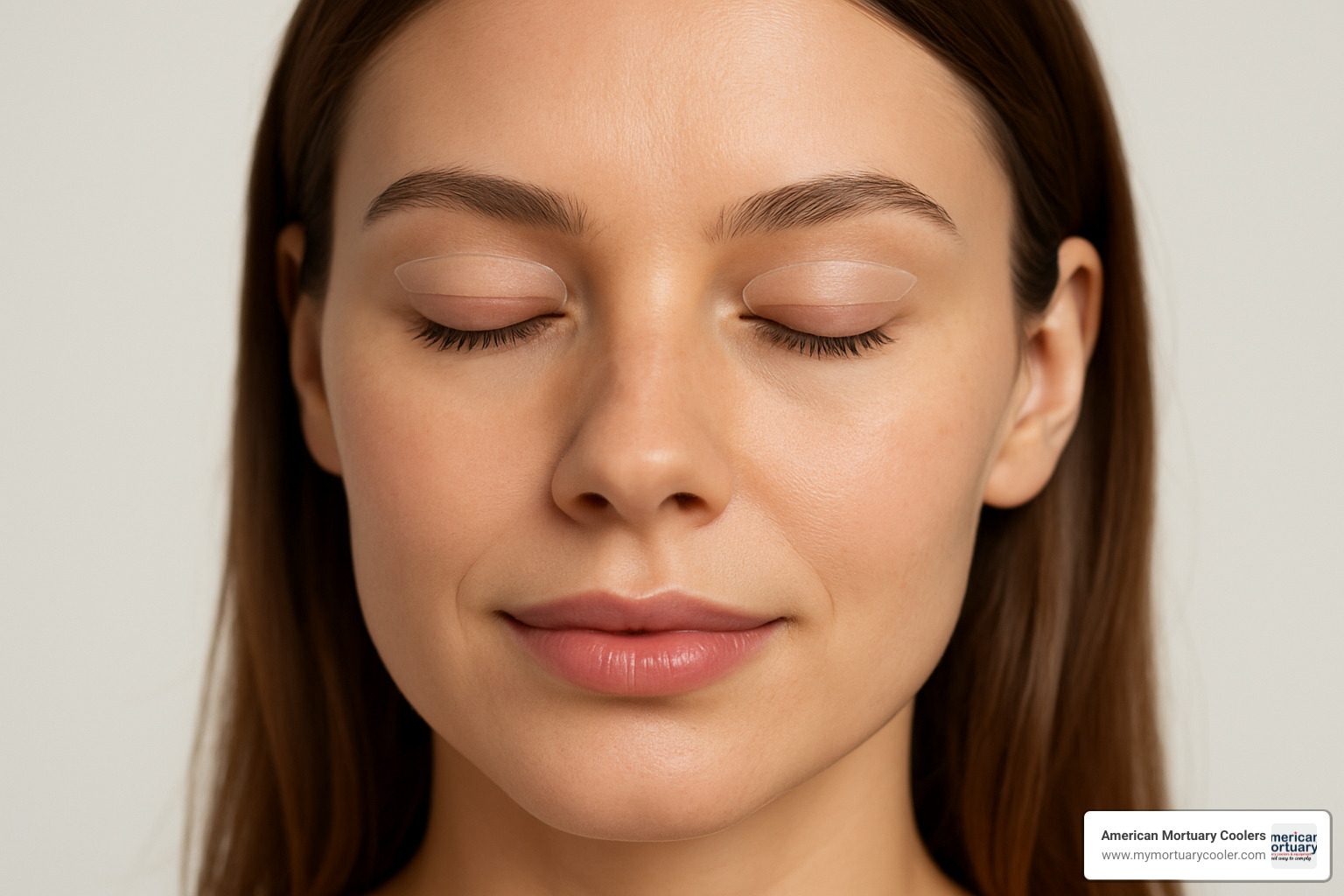
People with sleep apnea who use CPAP machines often struggle with dry eyes from air leakage. As one ophthalmologist shared: "SleepTite/SleepRite is my first choice to combat morning dryness from CPAP machines in those with Obstructive Sleep Apnea. It does not interfere with the fit of CPAP and protects the ocular surface while the patient sleeps." These specialized eyelid seals serve a therapeutic purpose, helping maintain eye moisture during overnight treatment.
In the beauty world, makeup artists and cosmetic enthusiasts use eyelid tapes and lifts to create a more youthful appearance. These products temporarily lift sagging eyelids or create the appearance of a double eyelid – quite different from mortuary applications, but similar in their goal of affecting eyelid position.
Even those suffering from chronic dry eye sometimes turn to overnight eyelid seals to maintain moisture while sleeping, preventing the discomfort of morning dryness.
Alternatives to Eyelid Caps
When traditional eyelid caps aren't the right solution, several alternatives exist. In modern mortuary practice, some funeral directors occasionally use adhesive methods or special mortuary waxes and fillers instead of caps, though these approaches are generally less common and reliable for extended viewing periods.
For medical purposes and living applications, the options are more varied. Simple medical paper tape (like EyeLocc strips) can temporarily seal eyelids for short procedures. Bubble bandages provide protection for injured eyes, while moisture goggles help those with severe dry eye maintain humidity. In more extreme cases, temporary surgical tarsorrhaphy might be recommended – a procedure where the eyelids are partially sutured closed.
The cosmetic market offers its own alternatives, with products like LIDS BY DESIGN strips, Eye Magic corrective strips, and Contours Rx eyelid lifts providing temporary aesthetic improvements. One satisfied customer shared: "I have had droopy eye lids my whole life. Now that I'm 50 they cover my eyelashes, but not anymore! I used all the sizes with great results."
When Are Eyelid Caps Better Than Tape?
In the funeral profession, traditional eyelid caps typically outperform tape and other alternatives for several important reasons. Their needle-point perforations create a stronger, more reliable grip that maintains closure throughout extended viewing periods – something adhesives can't always guarantee.
For cases where the eyes appear sunken or where eye donation has occurred, eyelid caps do more than just close the eyelids – they help restore the natural contour and fullness of the eye area. This restoration of shape is something tape simply cannot achieve.
Funeral directors also appreciate that eyelid caps leave no adhesive residue on the skin, which can be particularly important in achieving a natural, unmarked appearance. The caps remain completely hidden from view when properly placed, maintaining the illusion of natural sleep.
Perhaps most practically, eyelid caps provide reliable closure during transportation of the deceased. When moving between facilities – from hospital to funeral home, or funeral home to church – the secure closure prevents any unsettling changes in appearance.
At American Mortuary Coolers, we've worked with funeral homes across the country – from Atlanta to Chicago to Dallas – and have found that most consider eyelid caps essential inventory items for their preparation rooms. These simple tools play a crucial role in creating the peaceful, dignified appearance that brings comfort to grieving families.
Benefits, Limitations, Risks & Common Misconceptions
When it comes to creating a peaceful final appearance, eyelid caps truly shine in mortuary practice. These simple tools make a world of difference for families during viewings.
The benefits of using eyelid caps go beyond just keeping eyes closed. They create a natural, restful appearance that brings comfort to grieving families. This natural look helps preserve the dignity of the deceased throughout the viewing and services – something every family deserves.
For funeral professionals, the efficiency of eyelid caps is a real advantage. Experienced embalmers can apply them quickly, which helps streamline the preparation process when time matters. What's more, these versatile tools work effectively regardless of eye condition or whether donation has occurred.
"The reliability factor can't be overstated," one funeral director told me. "Unlike adhesives or sutures that might fail during a long viewing, properly placed eyelid caps stay put when you need them to."
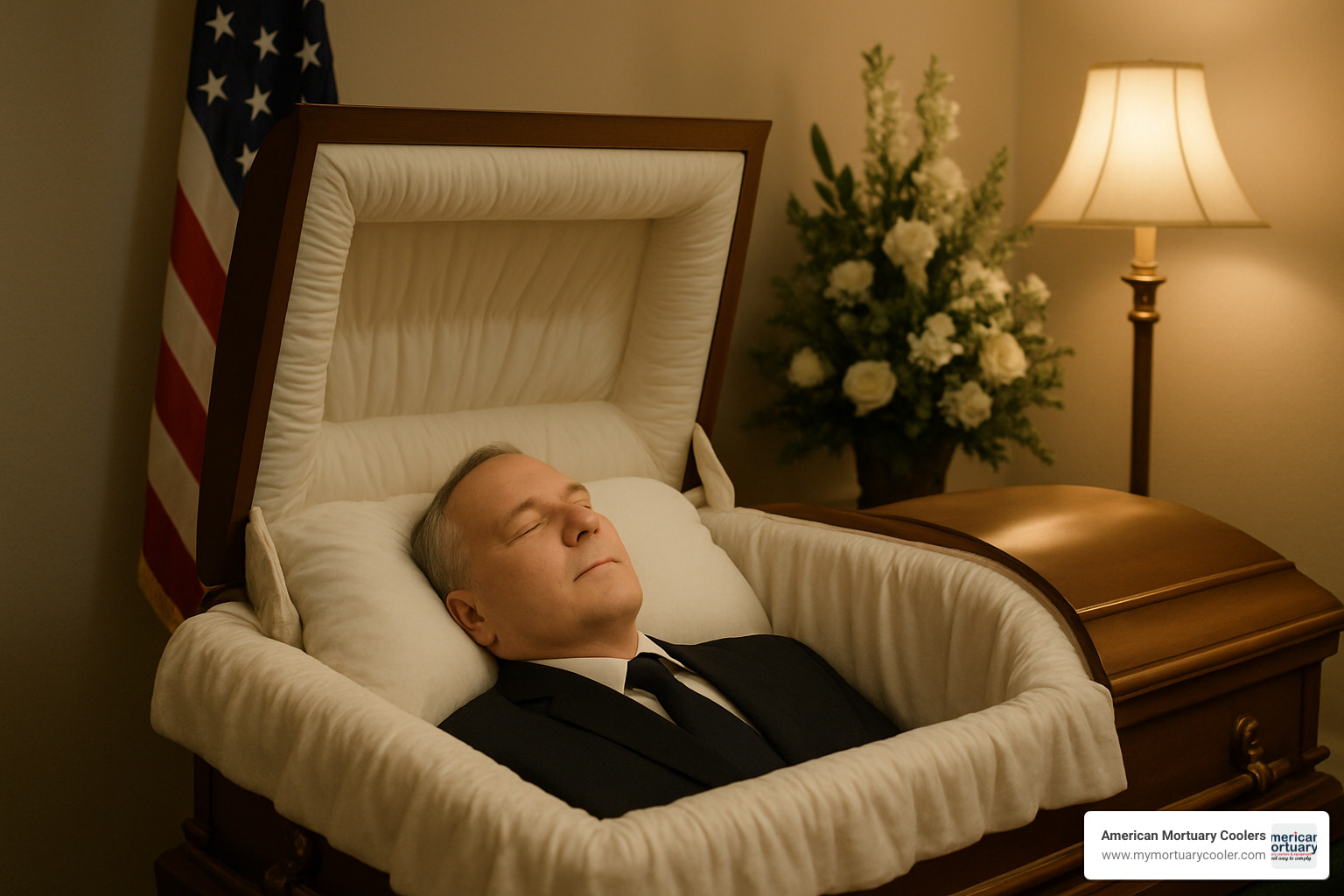
Limitations and Risks
Despite their many advantages, eyelid caps aren't without limitations. Proper application requires training and experience – it's truly an art form that takes practice to master. Using the wrong size cap can result in an unnatural appearance or inadequate closure, which is why experienced embalmers keep various sizes on hand.
Improperly placed caps might create visible indentations or distortions, something professional embalmers work carefully to avoid. In rare cases involving significant facial trauma or certain eye conditions, alternative methods might be necessary.
Like all mortuary tools, proper sanitation is essential. Professional standards require that eyelid caps are never reused between cases – a practice we strongly emphasize in our training materials at American Mortuary Coolers.
Top Misconceptions About Eyelid Caps
I've heard all sorts of misconceptions about eyelid caps over my years in the industry. Perhaps the most common is the belief that "eyelids are glued shut." The reality is that eyelid caps use mechanical friction from their tiny perforations, not adhesives, to maintain closure.
Another myth I often hear concerns cost. Some people believe eyelid caps are prohibitively expensive, but at $7-30 per pack of 100, they're actually among the more affordable preparation supplies, costing mere cents per case.
The idea that caps are reused between cases makes me cringe a bit. Professional standards are crystal clear – eyelid caps are single-use only and are never reused between different individuals. It's a matter of dignity and proper sanitation.
I sometimes hear concerns about discomfort for the deceased. It's worth gently noting that post-mortem, there is no sensation, and properly placed caps create no discomfort whatsoever.
Finally, while eyelid caps are standard across the industry, application methods do vary between practitioners and regions. Each funeral professional develops their own approach based on their training and experience.
Potential Complications and How Professionals Mitigate Them
Professional embalmers develop skills to prevent and address potential complications with eyelid caps. Experienced practitioners stock multiple sizes and select appropriately based on the individual's features to avoid sizing issues.
To prevent pressure indentations, proper placement and careful monitoring are essential. Meticulous attention to detail ensures both eyes appear symmetrical and natural – a small thing that makes a big difference for viewing families.
"One trick I've learned over the years," shared a veteran embalmer, "is combining caps with appropriate complementary products like cavity fillers to ensure lasting results, especially for longer viewings."
At American Mortuary Coolers, we believe in supporting funeral professionals with the knowledge they need. Our training resources emphasize these best practices to ensure optimal results whether you're serving families in Boston, Chicago, or San Diego. After all, every family deserves the same level of care and dignity during their most difficult moments.
Buying Guide: Costs, Sizing, and Ethical Considerations
Shopping for eyelid caps doesn't have to be complicated, but there are a few important things to consider before placing an order for your funeral home. Let's walk through what you need to know to make the best choice.
Most funeral homes find that a standard pack of 100 eyelid caps costs between $7 and $30, making them one of the more affordable items in your preparation room inventory. When you break it down, that's just pennies per case - a small investment for the peace of mind and dignified appearance they provide to families during viewings.
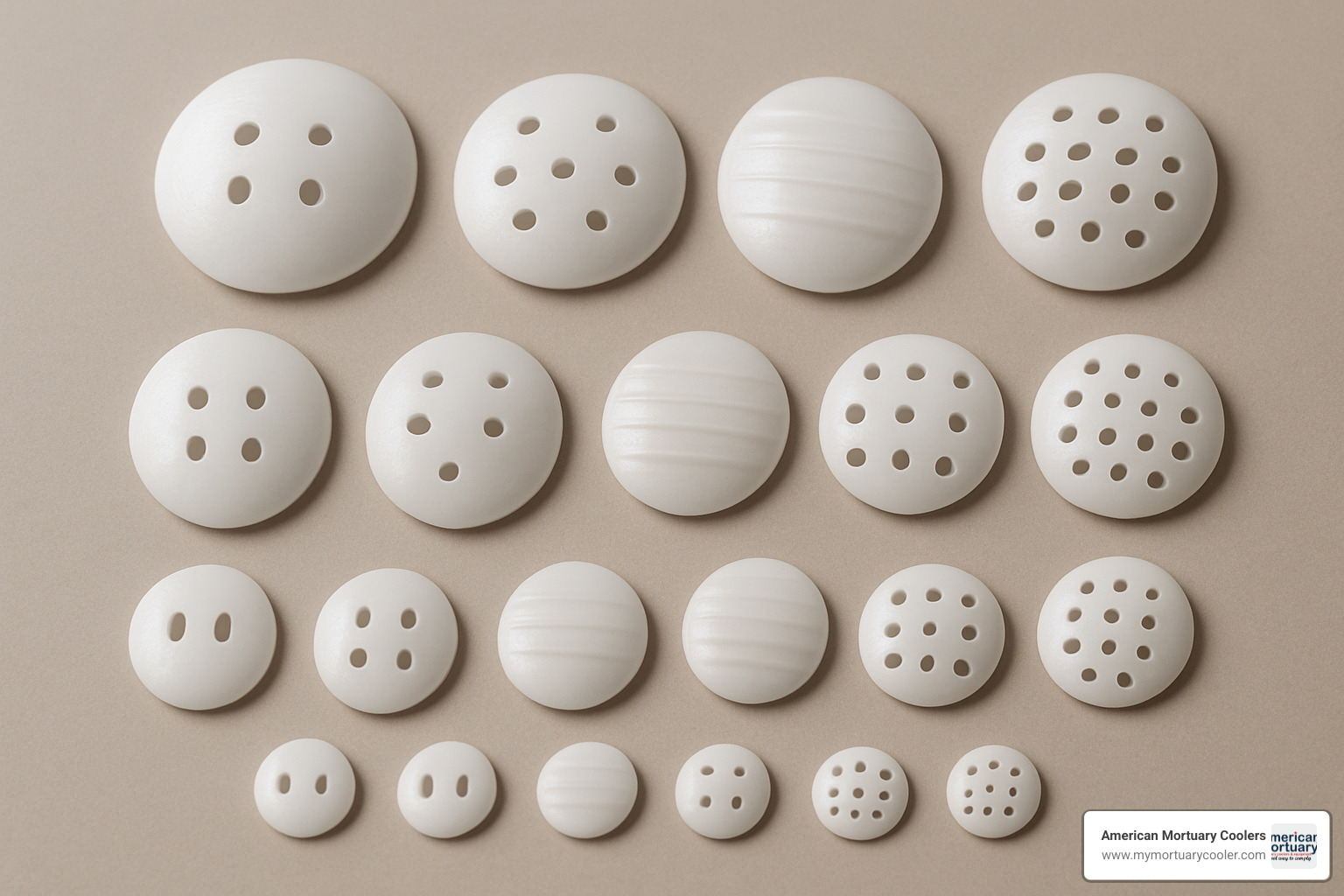
If you're looking to save a bit more, many suppliers offer generous discounts for bulk orders. For larger funeral homes or those with multiple locations, buying in larger quantities makes good business sense. The caps store well and don't expire, so stocking up won't lead to waste.
When it comes to sizing, most manufacturers keep it simple with standard sizes that work for the majority of cases. However, if you serve a diverse community, you might want to keep a few different sizes on hand:
- Small/pediatric sizes for children or smaller individuals
- Standard/medium sizes for most adults (this is what most funeral homes primarily stock)
- Large sizes for larger individuals
Think about who your funeral home typically serves when deciding which sizes to keep in inventory. Most funeral directors find that the standard size works for about 90% of their cases, with just a few situations calling for specialized sizes.
Where to Purchase Eyelid Caps and What to Look For
When it's time to restock your eyelid caps, you have several options. Traditional funeral supply companies are always reliable choices, offering professional-grade products with consistent quality. Many directors also appreciate the convenience of online distributors, which often feature competitive pricing and quick delivery.
For larger funeral homes or those looking to maximize their budget, wholesale suppliers can offer significant savings on bulk orders. And believe it or not, there's even a small market for vintage mortuary tools, including antique eyelid caps (though these are collectors' items, not for professional use).
When selecting your caps, pay attention to the quality markers that matter:
Look for eyelid caps with consistent, well-formed perforation patterns. These tiny holes are what create the friction that keeps the eyelids closed, so their quality directly impacts performance. Medical-grade materials are also important - they should feel smooth yet slightly tacky to the touch.
Good suppliers package their caps properly to maintain sanitation until use. Clear sizing information and compatibility with your other preparation products are also worth checking before purchase.
At American Mortuary Coolers, we're happy to guide funeral professionals through selecting quality preparation supplies, including eyelid caps. It's just one way we support funeral homes across the country alongside our primary focus on durable, custom mortuary coolers.
Ethical & Cultural Perspectives on Eye Closure
The practice of ensuring peaceful closure of the eyes after death is nearly universal across cultures, though the specific methods vary widely. This shared human instinct speaks to our desire to see our loved ones at rest.
In Christian traditions, peaceful repose with closed eyes symbolizes the "sleep" before resurrection. Jewish preparation teams (Chevra Kadisha) handle eye closure with specific protocols as part of their reverent preparation process. For Islamic communities, gentle eye closure is integrated into the ritual washing (Ghusl) performed before burial.
Buddhist and Hindu traditions may approach this differently depending on the region and specific community practices. What remains consistent is the care taken to ensure dignity in this aspect of death care.
Today's funeral directors increasingly consult closely with families about all aspects of preparation. Some families may have specific requests based on the deceased's personal preferences, cultural background, or religious requirements. Whether planning an open or closed casket service also influences these decisions.
While eyelid caps are standard in Western funeral practice, other methods are common elsewhere. Some traditional practices use weighted coins or stones, while others employ silk or cotton pads. In some regions, simple manual closure without devices is preferred.
As funeral practices evolve to accept more eco-conscious approaches, many funeral homes are exploring biodegradable alternatives for preparation tools, including eyelid caps. This reflects a growing awareness of environmental impact across all aspects of funeral service.
At American Mortuary Coolers, we understand that every detail matters when caring for the deceased. From the major equipment like our custom mortuary coolers to the smaller supplies like eyelid caps, each element contributes to providing families with meaningful, respectful farewell experiences.
For more information about essential preparation room supplies, you might find our comprehensive buying guide helpful, or learn more about embalming supplies and equipment.
Frequently Asked Questions about Eyelid Caps
What size eye cap should I stock in the prep room?
When it comes to eyelid caps, finding the right inventory balance is something we help funeral directors with all the time. Most funeral homes do just fine keeping primarily medium-sized caps on hand, as these work for the majority of cases you'll encounter.
That said, I always recommend maintaining a thoughtful mix:
"I keep about 80% medium caps, with a small supply of both small and large sizes for those special cases," one funeral director in Ohio told me recently. "It's better to have them and not need them than the other way around."
From our experience delivering to funeral homes from Maine to California, a single 100-pack of standard size eyelid caps typically meets the monthly needs of small to medium funeral homes. The cost is minimal compared to the peace of mind of having the right tools available when you need them.
Can eyelid caps be reused?
I get this question surprisingly often, and the answer is an emphatic no. Eyelid caps should never be reused between cases, full stop.
This isn't just about professional standards—though those certainly matter. It's about dignity and respect. Each person deserves their own fresh preparation materials. Besides, considering eyelid caps typically cost less than 30 cents per pair, there's simply no reason to consider reuse.
Beyond the ethical considerations, there are practical reasons too. The tiny perforations that make eyelid caps work can become less effective after a single use. Even thorough cleaning can't guarantee the caps will perform as designed a second time.
Many states have specific regulations prohibiting the reuse of any preparation materials, so keeping your practice single-use only helps ensure you're always in compliance with local regulations.
Do living patients ever need eyelid caps?
While living patients don't use mortuary-style eyelid caps, they do benefit from similar concepts adapted for the living. The medical and cosmetic versions serve completely different purposes but share some design principles.
For instance, during radiation therapy, patients often need specialized eye shields to protect delicate eye tissues. As one radiation oncology guide explains: "Klarity Eye Shields provide reliable lens protection during radiation therapy, especially important for facial treatments."
People with certain sleep conditions sometimes use nocturnal eyelid seals, particularly those using CPAP machines who experience dry eyes. One sleep specialist shared with me: "When patients report morning dry eye symptoms, I immediately check for incomplete lid closure during sleep and often recommend eyelid seals as part of the solution."
In the cosmetic world, eyelid tapes have become increasingly popular for temporary correction of droopy eyelids. A customer using these products noted: "I have one eye that droops noticeably more than the other. Using a single eyelid tape creates symmetry that boosts my confidence daily."
These applications differ significantly from mortuary eyelid caps in their design and application, though they share the fundamental purpose of supporting the eyelid in different contexts.
At American Mortuary Coolers, we focus exclusively on professional mortuary supplies, but we believe understanding these related applications helps funeral professionals better explain their craft when families have questions about the preparation process.
Conclusion
Eyelid caps may be small in size, but they play an enormous role in creating peaceful, dignified presentations for families saying their final goodbyes. These simple devices help funeral professionals achieve that serene, restful appearance that brings so much comfort during difficult times.
It's fascinating to see how these tools have evolved over the years. What began as basic utility items have become thoughtfully designed instruments of care. Every curve, every perforation, every material choice in modern eyelid caps serves a purpose—helping create the most natural-looking results with minimal intervention.
Here at American Mortuary Coolers, we deeply understand that quality preparation requires quality tools. That's why we don't just focus on our custom mortuary coolers (though we're mighty proud of them, built right here in Tennessee and delivered to funeral homes across all 48 contiguous states). We also provide guidance on selecting the best preparation supplies, including eyelid caps, for funeral homes of every size and need.
The care that goes into details like proper eye closure reflects something beautiful about the funeral profession—a genuine commitment to dignity and respect. Whether you're serving families in the busy streets of Chicago, the warm communities of Dallas, the historic neighborhoods of Atlanta, or anywhere in between, these small considerations make a truly meaningful difference in final presentations.
The right tools make all the difference in creating peaceful, comforting moments for families. From the practical aspects of eyelid cap application to the installation of our durable, custom-built mortuary coolers designed specifically for your facility's unique needs, we're here to support your important work.
For more information about mortuary preparation equipment, supplies, or our custom mortuary coolers, please reach out to us at American Mortuary Coolers. Our team stands ready to support you with both the knowledge and equipment needed to provide truly exceptional care to the families you serve.
